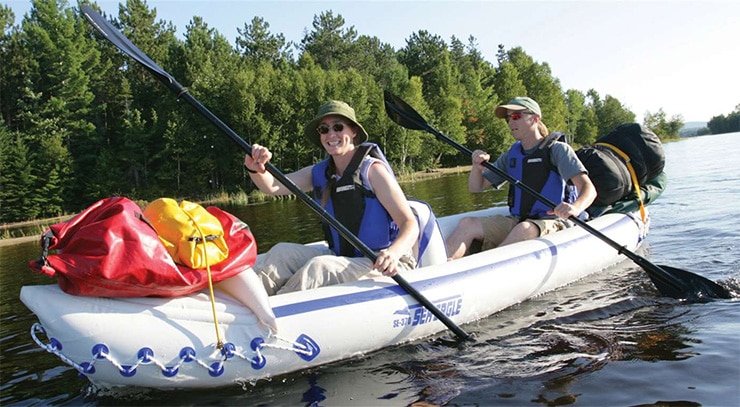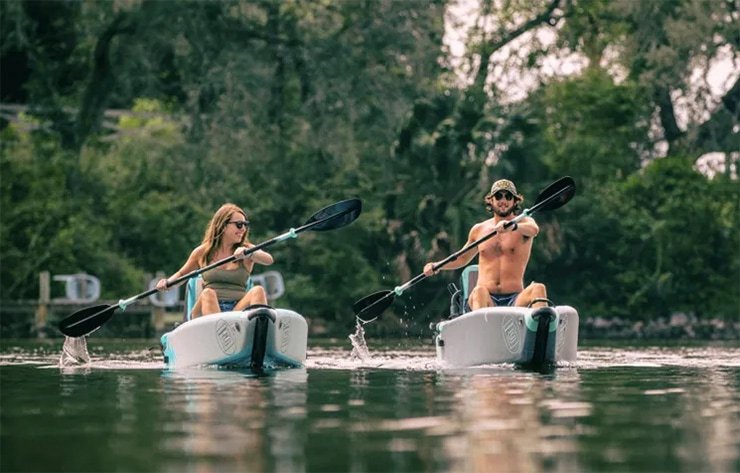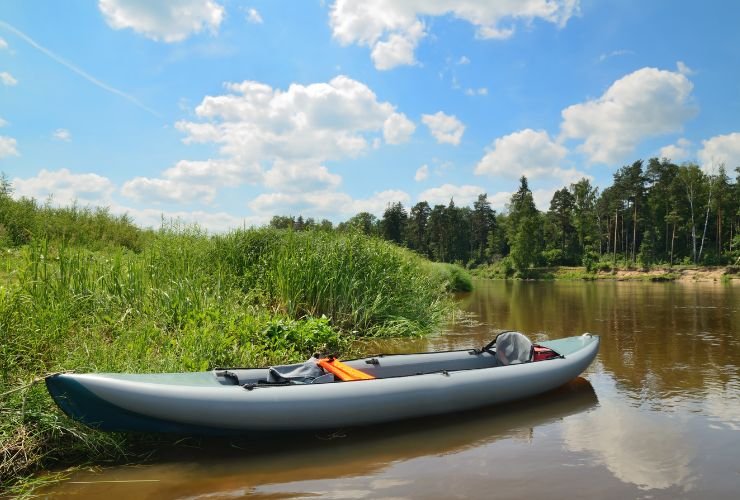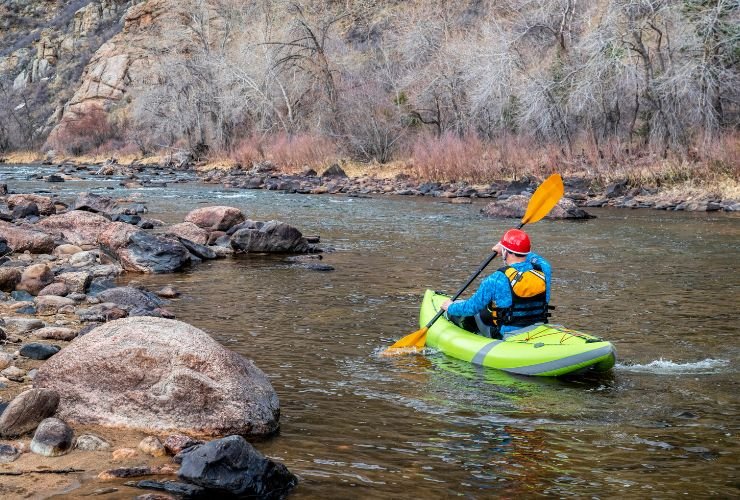Are you thinking of buying an inflatable kayak but not sure what material to choose? Do you want to know the pros and cons of different inflatable kayak materials and how they affect the performance and durability of your kayak? If so, you have come to the right place.
In this article, I will explain everything you need to know about inflatable kayak materials. I will compare the four main types of materials used to make inflatable kayaks: hypalon, PVC, nitrylon, and polyurethane. I will also tell you how they are bonded together and what factors you should consider when choosing a material.
By the end of this article, you will have a clear idea of what material suits your needs and preferences best. You will also learn how to take care of your inflatable kayak and make it last longer.
So let’s get started!
RELATED: How safe are inflatable kayaks?
Key Takeaways
- There are four materials commonly used to make inflatable kayaks: hypalon, PVC, nitrylon, and polyurethane.
- Hypalon is known for its durability. It’s a robust material that can withstand rough conditions. If you’re seeking a long-lasting kayak, consider hypalon.
- PVC kayaks are lightweight and often more affordable. They’re great for recreational use and easy to transport. However, PVC isn’t as durable as hypalon.
- Nitrylon strikes a balance between durability and weight. It’s eco-friendly and resistant to abrasions. If you’re conscious of the environment, nitrylon is a good choice.
- Polyurethane kayaks are lightweight and have good puncture resistance. They’re suitable for touring and recreational paddling.
The Different Types of Inflatable Kayak Materials
There are four main types of materials used to make inflatable kayaks: Hypalon, PVC, nitrylon, and polyurethane. Each of these materials has its strengths and weaknesses.
Check them out.
| Material | Pros | Cons |
| Hypalon | – Remarkable resistance to chemicals and the elements – High heat resistance – Super durable and resistant to tears and punctures | – Expensive – Heavy |
| PVC | – Affordable and easily accessible – Lightweight – Moderate resistance to UV and the elements | – Not as tough as hypalon – Not eco-friendly |
| Nitrylon | – Eco-friendly inflatable kayak material – Extremely durable | – Heavy |
| TPU | – Exceptionally lightweight – Excellent resistance to UV and other environmental factors | – TPU kayaks are hard to find |
Let’s learn more about each of these materials.

Hypalon: The Most Durable Inflatable Kayak Material
Hypalon is a tough synthetic rubber known for its durability, thanks to its remarkable resistance to the elements and chemicals. Hypalon is a registered trademark by DuPont Elastomers.
A popular kayak made with hypalon that you may recognize is the NRS MaverIK I inflatable kayak.
Pros of Hypalon
The biggest advantage of hypalon that sets it apart is its sturdiness and reliability. It is extremely resistant to UV, weather, and chemical damage. The material is also resistant to different environmental factors including mildew and fungus.
Hypalon inflatable boats can withstand heat levels up to 150 degrees Celsius as well as abrasion and different kinds of abuse.
A hypalon kayak can also maintain bright colors without deteriorating, thanks to its exceptional resistance to discoloration when exposed to sunlight.
Kayaks made using hypalon are less likely to tear and puncture. This makes them ideal for use in extreme conditions.
With proper maintenance, your hypalon kayak can last for decades.
Downsides of Hypalon
Good things, more often than not, don’t come cheap and this is the case with hypalon. It’s much more expensive than PVC and you have been keener with maintenance.
Hypalon kayaks are also heavier than PVC kayaks. It might not be fun having to carry your yak over a long distance on your back.
PVC: The Most Common Inflatable Kayak Material

While hypalon inflatable kayaks are harder to come by, PVC kayaks are much more popular. The material is also used in making inflatable paddle boards.
PVC or polyvinyl chloride is one of the most widely produced thermoplastics in the world. Sometimes you’ll see it referred to as polyvinyl or just vinyl.
This material can either be rigid or softened to make it more flexible. Flexible PVC is what’s used to build kayaks and other inflatable products.
Popular kayaks made using PVC include the Advanced Elements AdvancedFrame, Expedition Elite, Star Rival, and the Sea Eagle 370 inflatable kayaks.
Pros of PVC
Polyvinyl is cheap and easily accessible, which translates to PVC kayaks being cheaper. If you’re working with a tight budget you can get a good inflatable PVC kayak without putting a dent in your bank account.
On top of that, polyvinyl is lighter which is a huge plus. Many people buy an inflatable boat because of the ease of transport and having a lighter one definitely helps.
Although it’s not as tough as hypalon, PVC has good durability and some resistance to UV and other corrosive chemicals. Manufacturers also use UV protectants to make PVC kayaks last longer. Quality inflatable kayaks made using vinyl can last for over a decade if taken good care of.
Downsides of PVC
While PVC kayaks are durable, they are not as UV resistant as hypalon kayaks and they need a UV protectant.
PVC has limited thermal capacity and exposure to high temperatures and chemicals can compromise it.

Nitrylon: The Eco-Friendly Inflatable Kayak Material
Nitrylon is a much more environmentally friendly kayak material. It is becoming increasingly popular, partly because of the rising claims about PVC material being harmful to the environment. This rubber material is incredibly strong and high-quality.
Innova Twist LN and the Innova Solar 410C inflatable kayaks are examples of kayaks made using nitrylon.
Pros of Nitrylon
Nitrilon is more eco-friendly compared to the more commonly used PVC. It doesn’t contain the harmful chemicals in PVC kayaks that are released into the environment.
This material has superior durability as well. It doesn’t tear or puncture easily which is a great quality for kayak material, especially for whitewater kayaking.
Downsides of Nitrylon
Nitrylon is a heavy material and so manufacturers prefer to use it only on some sections of the kayak instead of the entire kayak.
Polyurethane: Lightest Kayak Material
Thermoplastic polyurethane or TPU is a type of polyurethane plastic known for its resistance to abrasion as well as oil and grease.
A TPU kayak you may recognize is the Aquaglide’s Cirrus Ultralight 110.
Pros of Polyurethane
Thermoplastic polyurethane kayaks are extremely lightweight and easy to carry around. The material allows kayakers to have super light kayaks without sacrificing durability.
Urethane is quite durable with remarkable resistance to UV, punctures, mold, and abrasions.
TPU is also much more eco-friendly compared to PVC.
Downsides of Polyurethane
Thermoplastic polyurethane is still new in kayak manufacturing so TPU kayaks are hard to find.
Inflatable Kayak Seam Bonding Methods

There are two main methods used to bond kayak seams: heat welding and adhesive bonding.
Heat Welding
Heat welding or thermo-welding involves using heat to fuse the two layers of fabric into one. This creates a strong bond that will last.
Heat-bonded seams can withstand high pressure so they are less likely to be affected by temperature changes.
Adhesive Bonding
In adhesive bonding, the manufacturer uses glue to bond the seams.
The main downside to using glue is that it will weaken over time. The weakening will happen even faster in high heat and humidity conditions.
Which Is the Better Inflatable Kayak Material?
The answer to this question will vary from kayaker to kayaker. Different materials have their pros and cons. Ultimately, it all comes down to how you intend to use the kayak, your budget, and your personal preference.
Consider a hypalon kayak if you:
- Want an exceptionally durable kayak that can withstand abuse
- Don’t mind paying more
- Don’t mind having a heavier inflatable kayak
A PVC kayak is more suited for you if you:
- Have a tight budget
- Want a durable kayak that’s not too heavy
A nitrylon kayak would be ideal if you:
- Are keen about eco-friendly products
- Are looking for a tough kayak that will last
- Don’t mind a heavier kayak
Lastly, consider a TPU kayak if you:
- Plan on traveling a lot and need an exceptionally lightweight kayak
- Want a durable kayak that can handle rough conditions but isn’t heavy

Frequently Asked Questions About Inflatable Kayak Materials
What Materials Are Used to Make a Kayak?
Inflatable kayaks are made using hypalon, nitrylon, urethane, and PVC.
What’s the Difference Between PVC and Hypalon?
Hypalon is synthetic rubber while PVC is synthetic plastic. Both materials are used to make kayaks. Hypalon has excellent resistance to UV, chemicals, and other environmental factors. PVC is more affordable and easily available.
Final Thoughts
Inflatable kayaks are not all made from the same material. There are at least four materials used in the construction of inflatable boats. The type of material used to make a kayak determines its durability. However, this also depends on how you care for your kayak.
Every one of the inflatable kayak materials above has its pros and cons. Hypalon is tough and long-lasting but heavy. PVC is cheaper and lighter but not very eco-friendly.
So when choosing a kayak material you have to consider your budget, preference, and kayaking style.

